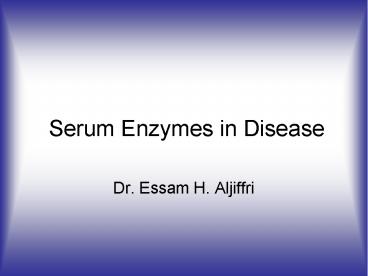Serum Enzymes in Disease - PowerPoint PPT Presentation
Title:
Serum Enzymes in Disease
Description:
Title: CLINICAL CHEMIISTRY (MT 305) CARBOHYDRATE LECTURE ONE Author: admin Last modified by: dell Created Date: 9/21/2003 10:46:45 AM Document presentation format – PowerPoint PPT presentation
Number of Views:441
Avg rating:3.0/5.0
Title: Serum Enzymes in Disease
1
Serum Enzymes in Disease
- Dr. Essam H. Aljiffri
2
Myocardial Infarction
- Necrosis of the myocardium leads to the release
into the circulation of tissue enzymes,
particularly CK, AST and LDH (HBD), these are
released from the heart and cleared from the
circulation at different rates.
3
Myocardial Infarction
- The first to rise is CK, activities being raised
within 6 h of myocardial infarction. - Total CK reaches a peak at 24-36 h, slightly
later than the maximum activity of CK-MB
isoenzyme. - In uncomplicated cases, CK returns to normal in 3
days.
4
Myocardial Infarction
- Serum AST rises more slowly, reaching a maximum
activity at about 48h and returning to normal in
4-5 days. - No significant elevations in HBD are seen for the
first 24 h values reach a maximum at about 3
days and remain elevated for up to 8 days.
5
(No Transcript)
6
Myocardial Infarction
- CK and HBD are useful indicators of myocardial
infarction, and are more specific than AST. - CK from skeletal muscle may be raised following
an intramuscular injection, chest compression for
resuscitation or electrical defibrillation.
7
Muscle Disease
- Skeletal muscle is a rich source of several
enzymes including CK, AST, ALT, aldolase and LDH.
- The measurement of total CK activity is the most
widely used enzyme in the investigation of muscle
damage. - This being increased most frequently and showing
the highest activities in diseases particularly
muscular dystrophies.
8
Muscle Disease
- Muscular Dystrophy
- The muscular dystrophies are a group of
genetically determined disorders of muscle. - Duchenne muscular dystrophy is an X-linked
recessive disorder caused by an abnormal
dystrophin gene and characterized by progressive
weakness of muscles from the age of 5 years.
9
Muscle Disease
- Muscular Dystrophy
- Raised serum CK activities occur before the onset
of clinical symptoms and values greater than 10
times the upper limit of normal. - Becker's muscular dystrophy is a form of muscular
dystrophy, affected males sometimes reaching
reproductive age.
10
Muscle Disease
- Toxic Myopathies
- Many drugs and chemicals may produce local or
generalized muscle damage. - Intramuscular injections may cause muscle damage
by two mechanisms, trauma and effect of the agent
being injected. - The latter may be caused by analgesics, a
possible cause of elevated CK activity which
should be considered in cases of suspected
myocardial infarction.
11
Muscle Disease
- Malignant Hyperpyrexia
- Malignant hyperpyrexia is a serious toxic
myopathy, this usually follows general
anaesthesia and in some cases have been described
after the administration of muscle relaxants. - High serum CK activities are seen during attacks.
12
Muscle Disease
- Traumatic Myopathies
- Causes of trauma to muscles in release of enzymes
include surgery, intramuscular injections and
post-exercise changes. - Serum CK values usually return to normal within
48 h of a single intramuscular injection. - Vigorous exercise of short duration and prolonged
moderate exercise may produce elevations in serum
CK, particularly in untrained athletes.
13
Liver Disease
- One of the transaminases is used as an indicator
of hepatocellular damage, ALT being more specific
for this purpose than AST. - Increase synthesis of alkaline phosphatase and
GGT in biliary cells are seen in cholestasis
14
Bone Disease
- ALP Level usually very high in Paget's disease of
the bone (greater than 10 times the upper limit
of normal). - Both primary and secondary bone tumours can cause
increases in alkaline phosphatase, typically up
to five times the upper limit of normal.
15
Enzymes in Urine
- Enzymes appear in urine from two sources
- by filtration of plasma and,
- by leaking from cells lining the urinary tract.
- Amylase is normally detected in urine, while
other serum enzymes are too large to cross the
glomerulus.
16
Enzymes in Urine
- Several enzymes derived from renal tubular cells
have been investigated as indicators of tubular
damage, particularly - alkaline phosphatase
- Nacetyl-beta-glucosaminidase (NAG),
- ALT and,
- GGT.
17
Haematological disorders
- Red cell enzymes activities may be abnormal
because of an inherited deficiency or due to
acquired disease. - Many inherited defects such as
- haemolytic disease,
- spherocytosis or,
- methaemoglobinaemia
18
Haematological disorders
- Genetic examples due to defective enzyme activity
of glucose-6-phosphate dehydrogenase (G6PD). - Synthesis of G6PD is controlled by an X-linked
gene and therefore males predominantly are
affected.
19
Haematological disorders
- Haemolytic anaemia may also be caused by other
enzyme defects including those affecting - pyruvate kinase,
- glutathione synthetase,
- hexokinase and,
- enzymes of the glycolytic pathway.
20
Haematological disorders
- Elevated serum LDH activities (owing to increases
in HBD) are found in various acquired
haematological disorders including - megaloblastic anaemias and,
- leukaemias.
21
Tissue Enzymes
- The estimation of tissue enzymes is usually in
the investigation of inherited metabolic
diseases, often being done on biopsy specimens
from specific tissues.






























